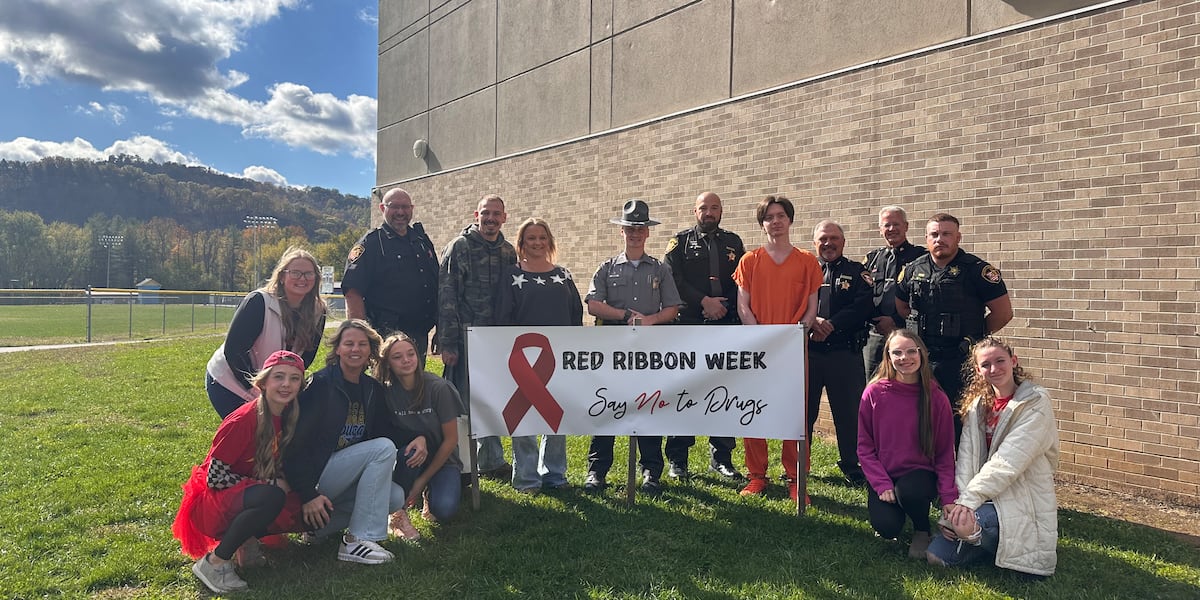Frontier High students hear personal stories promoting substance abuse awareness and education – WTAP

Community Initiative Addresses Substance Abuse in Alignment with Sustainable Development Goals
An educational event concluding Red Ribbon Week was held at Frontier High School in Matamoras, Ohio, to address substance abuse awareness. The program featured a multi-sectoral panel of speakers who provided perspectives on the consequences of substance abuse, directly supporting the United Nations Sustainable Development Goals (SDGs), particularly SDG 3 (Good Health and Well-being), SDG 4 (Quality Education), and SDG 16 (Peace, Justice and Strong Institutions).
Program Objectives and Alignment with SDG 3: Good Health and Well-being
The primary objective of the initiative was to strengthen the prevention of substance abuse among adolescents, a key component of SDG Target 3.5. By focusing on informed decision-making and the severe health risks associated with narcotics, the program aimed to promote long-term health and well-being within the student community.
Key Health-Related Themes:
- Fentanyl Crisis: Shelley Deem of Peer Solutions highlighted the lethal danger of fentanyl, which is often mixed with other substances, leading to unintentional overdoses and death. This directly addresses the need to reduce mortality from hazardous chemicals and contamination.
- Mental Health: Several speakers noted the link between mental health struggles, such as depression, and the decision to use substances. This underscores the importance of integrated mental and physical health services as part of SDG 3.
- Rehabilitation and Support: The role of organizations like Peer Solutions and the planned rehabilitation for inmate Elijah Stapp emphasize the treatment aspect of SDG Target 3.5, showcasing pathways to recovery.
A Multi-Sectoral Approach to Quality Education and Justice (SDG 4 & SDG 16)
The event employed a comprehensive educational strategy by incorporating speakers from various sectors, providing students with a holistic understanding of the issue. This approach aligns with SDG 4 by delivering essential, life-saving knowledge and with SDG 16 by involving institutions responsible for maintaining peace and justice.
Contributing Stakeholders:
- Law Enforcement (SDG 16): Representatives from the Washington County Sheriff’s Office and the Ohio State Highway Patrol discussed the legal ramifications of substance abuse. Sheriff Mark Warden emphasized the “ripple effect” of poor decisions, illustrating how individual actions impact family and community stability, thereby affecting the goal of peaceful and inclusive societies.
- Peer Support Organizations (SDG 3 & 4): Peer Solutions provided testimony from individuals with lived experience. Michael Kirk and Shelley Deem shared personal journeys with addiction and loss, serving as a powerful educational tool to deter substance use.
- Justice System Testimony (SDG 16): Inmate Elijah Stapp provided a direct account of how poor choices led to incarceration, offering a compelling perspective on the importance of the rule of law and the personal cost of criminal activity.
Key Messages and Outcomes
The Consequences of Decision-Making
A central theme was the profound and often irreversible impact of individual choices. Sheriff Warden’s analogy of a ripple in water was used to explain how a single decision can disrupt the lives of family members and the wider community, undermining community safety and well-being (SDG 11).
Personal Testimonies as Educational Imperatives
The personal stories provided critical, real-world context that traditional education methods may lack, contributing to a more effective and impactful learning experience (SDG 4).
- Elijah Stapp: The 22-year-old inmate described losing everything after making poor decisions as a teenager, highlighting the vulnerability of youth.
- Michael Kirk: His story detailed how adolescent experimentation evolved into a “lifetime of crime,” warning students that present actions directly impact future opportunities.
- Shelley Deem: Her account of losing her son to a fentanyl overdose underscored the finality of such decisions and stressed the importance of Good Samaritan laws, which protect individuals who call for emergency help and are a mechanism for ensuring access to justice and life-saving aid (SDG 16).
Student Impact
Initial feedback indicated the program was effective. Sophomore Mikayla Bennett noted that the personal stories “hit close to home,” suggesting that the event successfully conveyed its intended message and contributed to the students’ knowledge base for making healthy and responsible decisions.
Analysis of Sustainable Development Goals in the Article
1. Which SDGs are addressed or connected to the issues highlighted in the article?
The article primarily addresses issues related to health, well-being, education, and community safety, which connect to the following Sustainable Development Goals (SDGs):
- SDG 3: Good Health and Well-being: This is the most prominent SDG in the article. The entire event, Red Ribbon Week, is focused on substance abuse awareness. The personal stories from an inmate, a peer support specialist, and a mother who lost her son to a fentanyl overdose all highlight the severe health consequences of drug addiction, including mental health struggles and premature death.
- SDG 4: Quality Education: The article describes an educational event at Frontier High School where students hear from various speakers. The purpose is to educate them about the dangers of substance abuse and the long-term impact of their decisions. This directly relates to providing quality education on life skills and health.
- SDG 16: Peace, Justice and Strong Institutions: The involvement of law enforcement (Washington County Sheriff’s Office, Ohio State Highway Patrol) and the personal testimony of an inmate connect the issue of substance abuse to the justice system. The article touches upon crime as a consequence of addiction and the role of law enforcement in drug education. The mention of “Good Samaritan laws” also relates to legal frameworks designed to protect citizens and save lives.
2. What specific targets under those SDGs can be identified based on the article’s content?
Based on the article’s focus, the following specific SDG targets can be identified:
- Target 3.5: Strengthen the prevention and treatment of substance abuse, including narcotic drug abuse and harmful use of alcohol.
- Explanation: The Red Ribbon Week event is a clear example of a prevention effort. Speakers like Michael Kirk from Peer Solutions, who “try to educate and we try to help,” and Shelley Deem, who shares her son’s story to prevent similar tragedies, directly contribute to this target. The article also mentions rehab as a form of treatment for the inmate, Elijah Stapp.
- Target 3.4: By 2030, reduce by one third premature mortality from non-communicable diseases through prevention and treatment and promote mental health and well-being.
- Explanation: The tragic story of Shelley Deem’s 20-year-old son dying from a fentanyl overdose is a direct example of premature mortality linked to substance abuse. Her son was also “struggling with mental health and depression,” which connects the issue to the promotion of mental health and well-being as part of this target.
- Target 4.7: By 2030, ensure that all learners acquire the knowledge and skills needed to promote sustainable development, including, among others, through education for… sustainable lifestyles, human rights, gender equality, promotion of a culture of peace and non-violence, global citizenship and appreciation of cultural diversity.
- Explanation: The event at Frontier High School is designed to provide students with the knowledge and understanding of the consequences of substance abuse, promoting a sustainable and healthy lifestyle. Sheriff Warden’s talk on the “ripple effect” of decisions and the personal testimonies are educational tools aimed at equipping students with the skills to make informed choices.
3. Are there any indicators mentioned or implied in the article that can be used to measure progress towards the identified targets?
The article does not provide quantitative data, but it implies several qualitative and quantitative indicators that could be used to measure progress:
- For Target 3.5 (Prevention and treatment of substance abuse):
- Implied Indicator: The number and reach of substance abuse prevention programs in schools. The article describes one such event at Frontier High School, indicating that such programs exist. Progress could be measured by how many schools implement similar awareness weeks.
- Implied Indicator: Availability of treatment and support services. The mention of “Peer Solutions” and the inmate entering “rehab” points to the existence of these services. The call to action, “There are so many resources. You don’t have to do it alone,” suggests that tracking the utilization of these resources is a key measure of progress.
- For Target 3.4 (Reduce premature mortality and promote mental health):
- Implied Indicator: Mortality rate due to drug overdose. Shelley Deem’s story about her son’s death from a fentanyl overdose directly highlights this as a critical indicator. A reduction in such deaths would signify progress.
- Implied Indicator: Prevalence of mental health issues among youth. The article mentions that Shelley’s son was “struggling with mental health and depression,” linking it to his substance use. Tracking and addressing mental health issues in young people is an implied measure of progress.
- For Target 4.7 (Education for sustainable lifestyles):
- Implied Indicator: Integration of health and life skills education into school curricula. The Red Ribbon Week event serves as an example of this type of education. Measuring the extent to which schools provide comprehensive education on the consequences of substance abuse would be a relevant indicator.
4. Table of SDGs, Targets, and Indicators
| SDGs | Targets | Indicators Identified in the Article |
|---|---|---|
| SDG 3: Good Health and Well-being | Target 3.5: Strengthen the prevention and treatment of substance abuse, including narcotic drug abuse and harmful use of alcohol. |
|
| SDG 3: Good Health and Well-being | Target 3.4: Reduce premature mortality from non-communicable diseases through prevention and treatment and promote mental health and well-being. |
|
| SDG 4: Quality Education | Target 4.7: Ensure that all learners acquire the knowledge and skills needed to promote sustainable lifestyles. |
|
| SDG 16: Peace, Justice and Strong Institutions | Target 16.1: Significantly reduce all forms of violence and related death rates everywhere. |
|
Source: wtap.com
What is Your Reaction?
 Like
0
Like
0
 Dislike
0
Dislike
0
 Love
0
Love
0
 Funny
0
Funny
0
 Angry
0
Angry
0
 Sad
0
Sad
0
 Wow
0
Wow
0




















































.jpg.webp?itok=0ZsAnae9#)



























